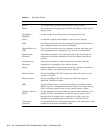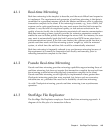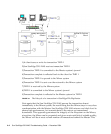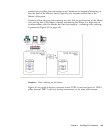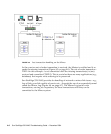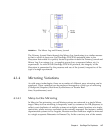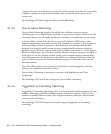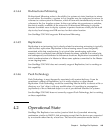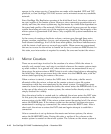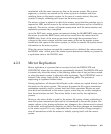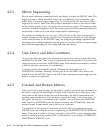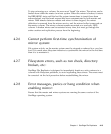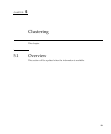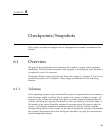
4-10 Sun StorEdge 5310 NAS Troubleshooting Guide • December 2004
opaque to the mirror service. Connections are made with standard UDP and TCP
protocols, so Sun StorEdge 5310 NAS servers can be mirrored across any reachable
network.
Since StorEdge File Replicator operates at the disk block level, the mirror system is
an exact replica of the master system. However, since mirroring operations are not
strictly real time, the mirror system may lag the master by a time delta dependent on
the speed and quality of the network. While this network lag may prevent the mirror
system from being an exact copy of the master at any given point, the integrity of the
mirror system is guaranteed at all times. Only complete file system transactions are
mirrored.
In the course of creating a duplicate volume, a mirror goes through three main
phases: creation, replication, or sync, and sequencing. StorEdge File Replicator is a
fault-tolerant technology. In all of the three main phases, the mirror handles errors
with the intent of self-recovery as much as possible. When errors are encountered
that are too severe for the mirror to handle on its own, it enters an ERROR state. In
this state, user intervention is required to remedy the error and restart the mirror.
4.2.1 Mirror Creation
There are several steps involved in the creation of a mirror. While the mirror is
actually only created once, each step is revisited whenever the master system starts
up after a reboot. As a general rule, when minor errors are encountered at any of
those steps, the mirror enters a RESET state to wait a short time before re-attempting
the failed step. More severe errors drive the mirror into the ERROR state, with the
mirror status specifying the nature of the error.
When a mirror is started, it enters the NEW state. In this state, a buffer area is
allocated within the mirror volume on the master system to store file system
transactions while they are transferred to the mirror system. If enough free space
cannot be found to accommodate the buffer, the mirror enters the ERROR state. If, as
in the case of the reboot of a master system, the mirror buffer already exists, it is
simply checked for validity.
Once the mirror buffer is created and/or validated, the mirror enters the INIT state.
At this point, the master system attempts to establish a network connection to the
mirror system via the NBD. If the mirror system cannot be reached at all, the mirror
enters the ERROR state. If the mirror system can be reached, but there are errors
encountered in setting up a connection, the mirror enters the RESET state. After a
short wait, the mirror re-enters the INIT state and again attempts to establish a
connection.
After a connection is set up between the master and mirror systems, the mirror
enters the MAKEPARTS state. During this state, a replica of the volume on the
master system is created on the mirror system. The volume on the mirror system is



